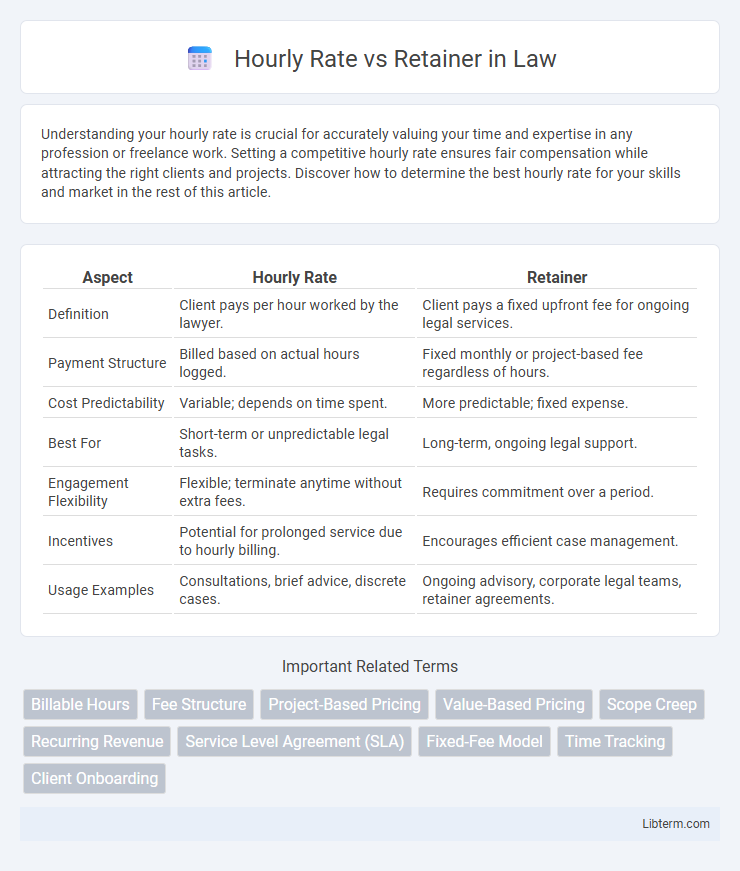Understanding your hourly rate is crucial for accurately valuing your time and expertise in any profession or freelance work. Setting a competitive hourly rate ensures fair compensation while attracting the right clients and projects. Discover how to determine the best hourly rate for your skills and market in the rest of this article.
Table of Comparison
| Aspect | Hourly Rate | Retainer |
|---|---|---|
| Definition | Client pays per hour worked by the lawyer. | Client pays a fixed upfront fee for ongoing legal services. |
| Payment Structure | Billed based on actual hours logged. | Fixed monthly or project-based fee regardless of hours. |
| Cost Predictability | Variable; depends on time spent. | More predictable; fixed expense. |
| Best For | Short-term or unpredictable legal tasks. | Long-term, ongoing legal support. |
| Engagement Flexibility | Flexible; terminate anytime without extra fees. | Requires commitment over a period. |
| Incentives | Potential for prolonged service due to hourly billing. | Encourages efficient case management. |
| Usage Examples | Consultations, brief advice, discrete cases. | Ongoing advisory, corporate legal teams, retainer agreements. |
Introduction to Hourly Rate vs Retainer
Hourly rate billing charges clients based on actual hours worked, offering flexibility for varying project scopes. Retainer agreements involve a fixed monthly fee, ensuring ongoing access to services and predictable expenses. Choosing between hourly rates and retainers depends on project consistency and client budget preferences.
Understanding Hourly Rate Agreements
Hourly rate agreements charge clients based on the actual time spent on a project, typically measured in increments such as 15-minute or one-hour blocks. This billing method offers flexibility and transparency, allowing clients to pay precisely for the work performed without upfront commitments. Understanding key elements like hourly rate calculations, tracking billable hours, and invoicing procedures is essential for managing expectations and ensuring fair compensation.
What is a Retainer Fee?
A retainer fee is an upfront payment made to secure ongoing services from a professional, often used in legal, consulting, or creative industries. It differs from an hourly rate by providing guaranteed availability or prioritized work rather than billing strictly by time spent. Retainers offer predictable cash flow for providers and budget control for clients, ensuring consistent access to expertise.
Key Differences Between Hourly Rate and Retainer
Hourly rate billing charges clients based on the actual time spent on a project, providing flexibility for short-term tasks and variable workloads. Retainer agreements involve a fixed upfront fee that secures ongoing services, offering predictable costs and priority access to resources over a specified period. The key difference lies in payment predictability and commitment, with hourly rates suited for sporadic work and retainers ideal for continuous, long-term engagements.
Pros and Cons of Hourly Rate Billing
Hourly rate billing offers flexibility by charging clients based on the actual time spent, ensuring fair compensation for varying project scopes. It can lead to unpredictability in costs, potentially causing budget overruns and client dissatisfaction. This model incentivizes detailed tracking of work hours but may reduce efficiency, as longer hours directly increase fees.
Pros and Cons of Retainer Agreements
Retainer agreements offer predictable monthly costs and ensure prioritized service access, ideal for ongoing projects requiring consistent support. They promote long-term collaboration and budget stability but may lead to underutilization or perceived overpayment if workload fluctuates unpredictably. Clients must assess their project needs carefully to avoid paying for unused hours and ensure the agreement aligns with their workflow demands.
When to Choose Hourly Rate
Choose an hourly rate when project scope is unclear or likely to change, allowing flexibility in billing based on actual work performed. This model suits short-term tasks, consultations, or when clients prefer detailed tracking of hours spent. Hourly rates provide transparency and ensure fair compensation for variable workloads and unforeseen project adjustments.
When to Opt for a Retainer
Choosing a retainer is ideal for projects requiring ongoing support, predictable budgeting, and prioritized access to expertise. Companies with continuous needs, such as marketing, legal, or IT services, benefit from the stability and stronger client-provider relationship a retainer fosters. This model suits long-term collaborations where deliverables are flexible, ensuring consistent availability without the unpredictability of hourly billing.
Factors to Consider Before Deciding
Hourly rates provide flexibility for unpredictable workloads, while retainers offer consistent income and budget stability for ongoing projects. Factors to consider include project scope, client relationship duration, payment predictability, and administrative overhead. Analyzing workload fluctuations, cash flow needs, and the value of long-term client engagement helps determine the optimal pricing model.
Conclusion: Selecting the Best Payment Structure
Choosing between an hourly rate and a retainer depends on project scope, predictability, and budget flexibility; hourly rates suit short-term, variable tasks while retainers benefit ongoing, consistent work. Retainers provide predictable monthly expenses and foster long-term client-provider relationships, enhancing service efficiency and accountability. Evaluating project demands and financial goals ensures selecting the optimal payment structure for sustainable collaboration.
Hourly Rate Infographic

 libterm.com
libterm.com